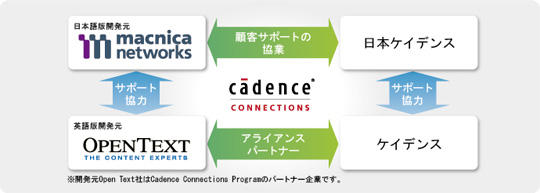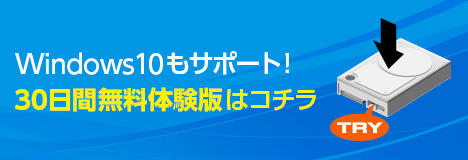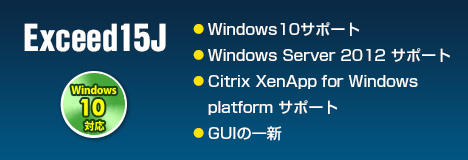product
- Exceed TurboX Product Information - Thin Client PC X Server
- Exceed Product Information - PC X Server
- Exceed Option - Secure Shell Product Information - Add-on program for SSH encryption support -
- Exceed options - Exceed 3D product information - Add-on program for OpenGL support -
- Exceed options - Exceed XDK product information - UNIX-Windows application porting tool -
- NFS Solo Product Information – PC NFS Client
- SOCKS Client Product Information - SOCKS Client
Specifications/Technical Information
Application for evaluation machine
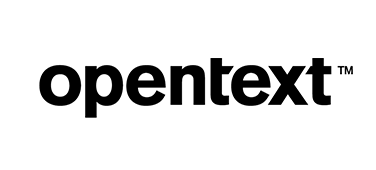
OpenText
open text
OpenText (formerly Hummingbird) - User Case - Cadence Design Systems Japan

EDA emulator for Windows
Japan Cadence with Exceed onDemand.
High response performance and OpenGL support
POINT
- Achieves both drawing performance that expresses the details of complex circuits and stress-free response
- Many improvements have been made by building a collaborative relationship over three years, and support capabilities in Japan have also been strengthened.
- Operating costs can be reduced by the floating license method
Cadence Japan has dual roles as EDA vendor and design partner
Cadence Design Systems Japan (hereafter, Cadence Japan), which started its activities in 1989 as a Japanese subsidiary of Cadence Design Systems (hereafter, Cadence) in the United States, has been working with major semiconductor manufacturers in Japan for more than 20 years. He has supported EDA (automation of electronic circuit design) for a semiconductor design company.
In addition to developing and selling software and hardware necessary for integrated circuit design, logic synthesis, verification, analysis, library/data management, etc., design services that make use of cutting-edge design know-how, analysis of design methods, and environment construction Cadence Japan provides a methodology service that supports EDA, and an education service that supports efficient design and development through tool training and teaching material development. supporting now.
Since around 2009, Cadence Japan has been considering introducing an emulator in order to build an environment in which Cadence products on Linux servers can be used from Windows PCs.
EDA development environments are generally operated on UNIX servers and Solaris or Linux workstations. Access from environments to servers and grid environments is increasing rapidly.
Event questionnaire survey reveals that 60% of companies are using Exceed onDemand
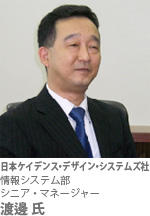
“We already had various emulators in use at the Company global bases, but we wanted to integrate them into one in Japan. We compared and evaluated it in the information system department,” says Mr. Watanabe, senior manager of the Japan Cadence System Department.
Watanabe emphasized the graphics performance and response time the most. As integrated circuits continue to shrink, drawing performance that accurately expresses even the smallest details of complex circuit designs is essential, and it is also an important condition that design data, which is increasing in volume, can be manipulated without stress even from remote locations. .
Although there were opinions pushing for the adoption of freeware due to cost advantages, the uncertainty of update information and the lack of support in the event of problems became problems. In addition, when most products use OpenGL, mouse operation and drawing speed are slow, and detailed wiring diagrams cannot be displayed, which is a fatal flaw as an EDA.
"Everything has advantages and disadvantages, and when I was about to give up because there was no emulator that could handle high-quality data, I learned of the existence of OpenText's Exceed onDemand (hereafter, EoD), and quickly added it to my evaluation. That's what I decided to do," says Watanabe.
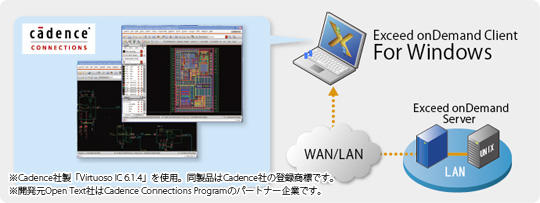
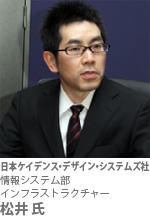
As a result, it turned out that the graphics performance and response performance were remarkably excellent. EoD's original protocol "Thin X Protocol" reduces communication traffic volume up to 1/100. EDA's minute data can also be drawn accurately, enabling use from low-bandwidth and remote locations.
In addition, as a result of taking a questionnaire at the Japan Cadence event, it was revealed that about 60% of the participating companies were already using EoD.
Furthermore, OpenText participates in the "Cadence Connections Program" as a partner company, verifying operations and functions to maximize productivity even in a mixed environment with Cadence products and other third-party tools. "It's really dark under the lighthouse."
Japan Cadence officially adopted EoD at the end of 2010. A year later, in December 2011, additional licenses were introduced.
Mr. Matsui of Infrastructure, Information Systems Department, Cadence Japan, who verified the emulator with Mr. Watanabe, is based on the cost merits of the floating license method by concurrent users of EoD and the realization of efficient management by the license server. , "It has been used smoothly without any particular problems since two years have passed since the start of operation," and highly evaluates its stability.
Proactive collaboration is necessary to solve customer issues in the future
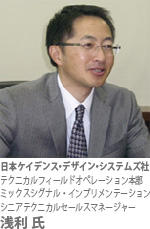
Even before EoD was adopted in Japan, Nippon Cadence and Macnica had been working together to supply products such as the PC X server "OpenText Exceed" (hereinafter referred to as "Exceed"). Since around 2009, when the Japanese version of EoD was developed, we have held regular monthly meetings with Nippon Cadence to exchange various information such as lending tools and licenses, reporting verification results, and solutions when problems occur. In addition, Macnica 's support team includes the engineer who developed the Japanese version of EoD, providing direct support.
As Exceed/EoD accounts for 60% of the market share, collaboration with OpenText and Macnica is extremely important for improving customer satisfaction at Cadence Japan, says Asari, Senior Technical Sales Manager, Mixed Signal Implementation, Technical Field Operations Headquarters, Cadence Japan. "EoD also had problems with display and performance at first, but through our three-year collaborative relationship, many improvements have been made and we are very satisfied with their support capabilities in Japan."
Currently, EoD is installed on about 80% of the terminals installed in Cadence Japan's training room, and services are provided in a manner similar to the usage conditions of customers. , it is useful for early detection of problems by reproducing the customer's design environment.
In addition, Cadence's overseas bases outside of Japan are also beginning to use EoD, as there is great value in adopting EoD, which has high basic performance and is used by many Japanese companies, as a Windows emulator. Mr. Watanabe says, ``The biggest mission of the information systems department is to evaluate and adopt software that internal users can use with peace of mind, while also being able to quickly resolve problems when they occur.'' He acknowledges that there have been no delays or problems, and that version updates have been done in a relatively timely manner, and explains the importance of Macnica developing the Japanese version.
"As many softwares begin to support multi-languages, there are increasing cases where headquarters cannot accommodate the detailed demands of Japanese people. However, with EoD, Macnica develops the Japanese version. Therefore, it is easy to incorporate local needs, and we can expect high-quality support in the future.'' (Mr. Watanabe)
Mr. Asari points out that EoD is increasing its presence in the domestic sales strategy of Cadence products. emphasizing the need for more active collaboration in order to
"We will continue to make proposals from the customer's perspective while sharing information with Macnica, such as problems occurring on the customer side and status updates." (Mr. Asari)
